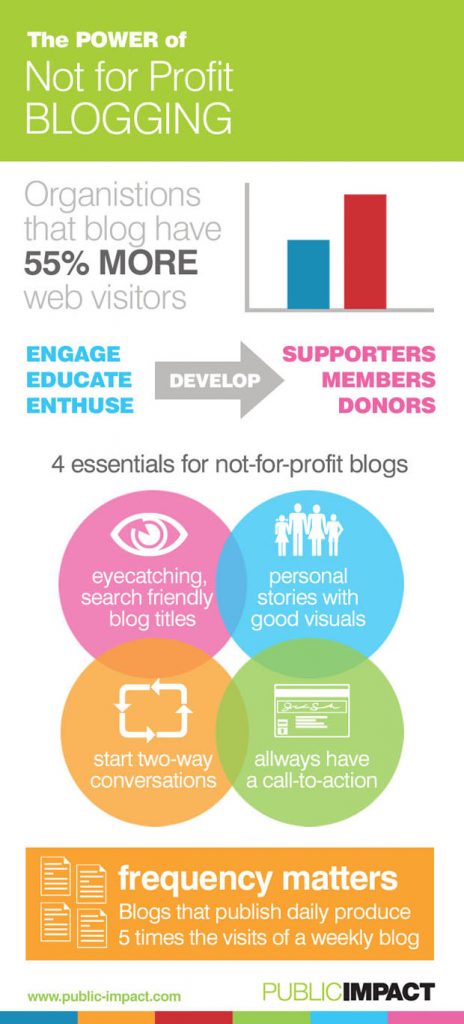Blogging is a fantastic tool for NGOs, charities and not-for-profit organisations. So why are so few UK not-for-profit organisations using it effectively? Analysis of the UK’s top charities reveals that only a small minority are using their blogs to maximum effect.
Blogging is an excellent way for NGOs, charities and not for profit organisations to engage new supporters and to raise the profile of the organisation on the web. Blogs get found by search engines and though the largest non-profits will be found easily through name recognition and direct search their home page won’t necessarily hold the information that the viewer is looking for.
Small and medium sized non-profits have most to gain from blogging
So even for the largest NGOs not to have a blog that engages supporters is a missed opportunity. But true as that is how much more important is that to the next tier? Small and medium sized not-for-profits have the most to gain from writing a better blog. Non-profit SMEs don’t have the pull of a household name, a massive research cause or a big TV ad campaign to support them – so they need to be found online and a well written, well promoted blog is one of the most cost-effective ways to get found.
BUT REMEMBER – running a blog take time and resources – most of all IT ISN’T FREE. So think it through before you start.

Here are ten easy ways to write better not-for-profit blogs and to use blogging to get more supporters and donors for your charity.
Use Lists
People love lists, the web loves lists but most important of all people search for lists. So ‘ten things you must know about your cause’ is always a great starting point for a blog post.
Titles and Headlines
Spend time thinking about headlines and titles. Because they matter – a lot. Ask yourself:
- Will they include search keywords?
- Will they capture attention?
- Will they get a message across that the article matters?
- Do they accurately describe what the article is about?
Structure and Layout
Design at every level is about providing an effective solution to a problem – not just looking good. Typographical design and blog structure matters because people read differently online to on paper. So use:
- sub heads that describe content effectively
- bullet points that make information easy to read.
- hyperlinks to other content and useful information (that also helps SEO)
- emphasis to get the most important point over
Short paragraphs, concise sentences
Online articles need pace and space. As well as a structure that makes it easy to scan your article quickly keep your sentences short. Think carefully about how you use paragraphs. While it may not be entirely correct to use three short paragraphs when you might use one in print it will make the piece more readable.
Not just words
Blogs are not just words. They can be infographics, collections of images, animations, sound files or video. All these things help the mix and keep it interesting for your readers. Remember too that every blog should have an image because images are found by search engines too.
Plain English is for people
Every profession has its lingua franca and every organisation has its jargon. Do yourself a favour and drop it – or at least keep it out of your blog. Why? Because it’s not about YOU. It’s about your potential supporters and they speak English! (or they speak French, or Spanish – but the same point holds – they don’t speak your jargon).
Current makes it matter
Writing about something that’s in the news right now is great – but it’s not always possible. Even so taking a peg of some sort from the news and hanging older content onto it is an excellent way to produce new blogs from old, making work that you have already done relevant to a new audience. Also not for profit websites are stacked full of information that can easily be turned into a blog and hung on news or current events.
Anecdotes make it real
Dry content that presents facts is all very well but especially in non-profit writing it is good to make blog stories about the real world. So include examples, user stories and anecdotes. In fact they are sometimesthe anecdote can be the inspiration for the whole blog.
The mission matters most
Non-profit blogs need to be varied and present their information in many different ways but remember that viewers become supporters, supporters become members and sympathisers become donors because they understand exactly what you do and the difference that their contribution can make to something they care about. That’s why your mission has to be part of what your blog is all about.
Now ask the reader to DO something
This is where most non-profit blogs fail. They tell an interesting story, they point out how important it all is and then they fail to ask the reader to do anything – whether it is to donate, join or sign a petition. A blog without a call to action is not worthless but it belongs in the academic world or the media – In non-profit it is a missed opportunity.

